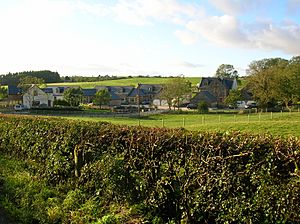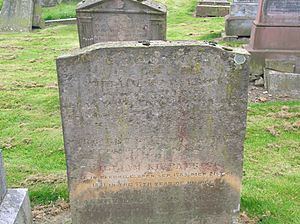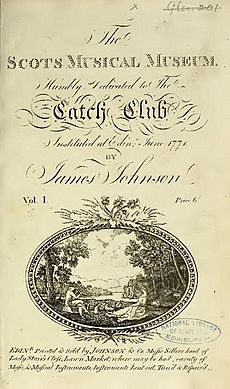Handsome Nell facts for kids
| by Robert Burns | |

Purclewan Mill, home to Nelly Kilpatrick
|
|
| Written | autumn 1774 |
|---|---|
| First published in | 1803 |
| Country | Scotland |
| Language | Scots |
| Form | Song |
| Publisher | James Johnson |
| Read online | "Handsome Nell" at Wikisource |
Handsome Nell is a famous song, often seen as a poem, written by Robert Burns. It was his very first song! He wrote it when he was just fifteen years old, in the autumn of 1774. The song was inspired by a young farm worker named either Nelly Kilpatrick or Nelly Blair. It was first printed in 1803, after Burns had passed away. This song is special because it marks the beginning of Burns's many love songs and poems.
Contents
What the Song is About
This song, set to a tune called I am a man unmarried, teaches an important lesson. It says that inner qualities like kindness, grace, and modesty are more important than just good looks. Handsome Nell was the first of many love songs Robert Burns would write. It shows how much he cared about women and love throughout his life.
The song was not published while Burns was alive. He kept it in his private notebooks, like his first commonplace book. Because of this, it wasn't included in his famous book Poems, Chiefly in the Scottish Dialect or other later editions.
Here is the poem itself:
Handsome Nell or O once I lov'd a bonnie lass
O once I lov'd a bonnie lass,
Aye, and I love her still;
And whilst that virtue warms my breast,
I'll love my handsome Nell.
Fal lal de dal etc.
As bonnie lasses I hae seen,
And mony full as braw;
But for a modest gracefu' mein,
The like I never saw.
A bonny lass I will confess,
Is pleasant to the e'e ,
But without some better qualities
She's no a lass for me.
But Nelly's looks are blythe and sweet,
And what is best of a' ,
Her reputation is compleat,
And fair without a flaw;
She dresses ay sae clean and neat,
Both decent and genteel;
And then there's something in her gait
Gars ony dress look weel.
A gaudy dress and gentle air
May slightly touch the heart,
But it's innocence and modesty
That polishes the dart.
'Tis this in Nelly pleases me,
'Tis this enchants my soul;
For absolutely in my breast
She reigns without controul.
Who Was Handsome Nell?
Robert Burns never fully named the girl in his song. He only called her "Nelly," which is a nickname for "Helen." There is some mystery about who she really was. At first, people thought she was Nelly Blair. An old letter from 1828 even said so.
However, Burns's youngest sister, Isobel, later said the girl was Nelly Kilpatrick. Isobel was only three years old in 1774, so her memory might not have been perfect. Nelly Kilpatrick was the daughter of the blacksmith at Perclewan Mill. Burns wrote that his Nell was a year younger than him. Nelly Kilpatrick was only a few weeks younger than him, which makes the story a bit confusing.
How the Song Came to Be
When Robert Burns was 15, he met "Handsome Nell." She was his first young crush. He described her as a "bonnie, sweet, sonsie lass" (a pretty, sweet, charming girl). But he never actually told her he liked her!
Nelly Kilpatrick, whose married name was Nelly Bone, first met Robert when his father, William Burnes, hired extra help for the harvest. This was at Mount Oliphant Farm. Robert and Nelly were paired together for work, which was a common custom in Ayrshire back then.
Burns later wrote about this time in a letter. He said that his harvest partner was a "bewitching creature" who was a year younger than him. He explained that she "unwittingly" (without meaning to) introduced him to his first feelings of love. He wondered why he liked to walk slowly with her after work. He also wondered why her voice made his heart race, and why his pulse beat so fast when he held her hand to remove nettle stings. He added that she sang beautifully, and he tried to write a poem for her favorite song. This is how "Love and Poesy" (love and poetry) began for him.
Burns's Thoughts on His First Song
In his Commonplace Book, Burns wrote about "Handsome Nell." He said it was his first work, written when his heart was "honest warm simplicity." He thought the poem was "puerile and silly" (childish and foolish).
But he also said he was always happy with it. It reminded him of those happy days when his heart was honest and his words were true. He believed the young girl truly deserved all the praise he gave her. He felt this way even years later, after their young romance had ended.
Burns wrote "Handsome Nell" while his family lived at Mount Oliphant Farm, near Alloway. This was in the autumn of 1774. In his first notebook, he changed one word in the poem. He changed "virtue" to "honor" in the first part. He also wrote that he wanted to criticize his own work. This was so that others wouldn't be too harsh on it.



